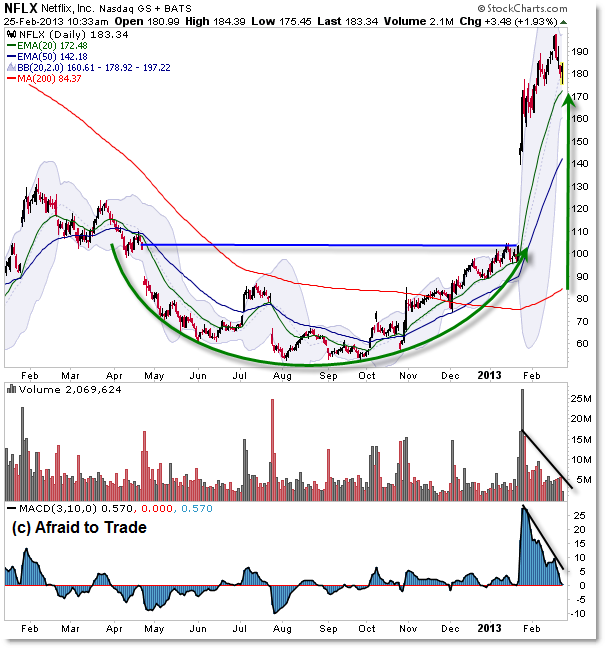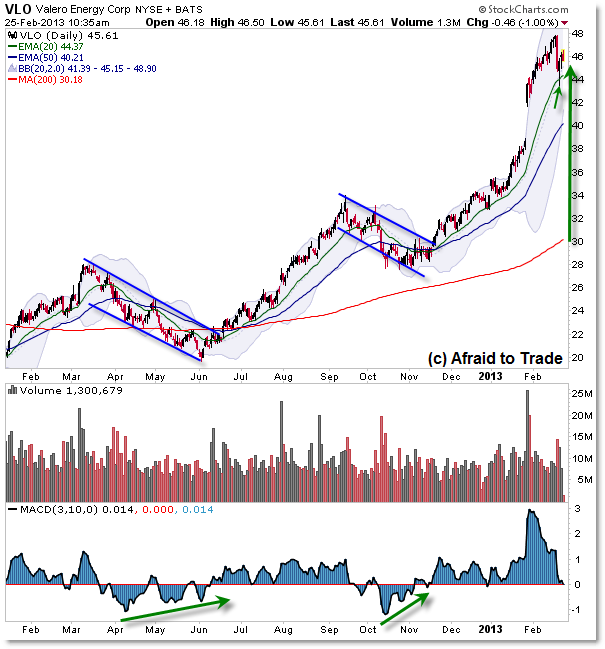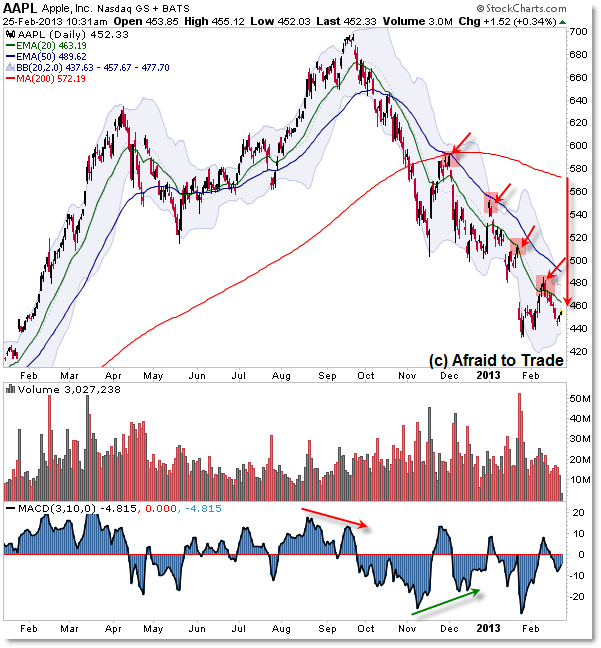February 25 Top 5 Stocks Most Extended from 200d SMA Scan
For this month’s update of the “Top Five S&P 500 Stocks Most Extended from their 200 day SMA,” we have two very popular stock names on opposite sides of the scanning results.
After a stellar reversal and strong rally, Netflix (NFLX) takes the top over-extended spot while Apple (AAPL) makes its debut in the top under-extended list.
Let’s take a look at the other stocks that made the list and what opportunities these stocks may provide.
The Top SP500 Overextended Stocks above their 200 day SMA:

It’s not often that we see stocks more than 100% above their 200 day moving average but Netflix (NFLX) accomplished this feat after a late 2012 reversal.

It took almost a full year to carve out a classic and beautiful “Rounded Reversal” pattern through 2012 and we see the outcome of the successful reversal.
Aggressive traders – especially those with longer time horizons – look to accumulate shares gradually over time as a stock is ‘carving out’ a bottoming pattern especially with divergences present.
Conservative traders, or those with shorter time horizons, tend to wait to join trends in motion on breakouts or retracements (like flag trades or pullbacks to rising moving averages).
In fact, that’s exactly how you can use a simple stock screen like the overextended scan:
Some traders prefer reversal strategies and will note that overextended stocks in mature will eventually reverse and they want to play for that elusive top or bottom; however, other traders who prefer pro-trend strategies (trading breakouts and retracements) will use this list as a starting point to locate current or future retracement opportunities.
A sharp retracement currently occurred in the #4 overextended stock, Valero Energy (VLO):

I also highlighted two prior lengthy ‘retracements’ that took the form of larger bull flags or “AB=CD” Measured Move patterns.
Tesero (TSO), the 5th most overextended stock, shows a very similar structure and pattern as Valero (VLO) – both are in the Basic Materials sector.
While the market has been in a persistent uptrend, not all stocks have been able to participate to the upside.
The next list reveals the Top 5 Stocks Most Extended Beneath their 200 day Moving Average:

In my prior update from November, Cliff’s Natural (CLF) made the list though it traded at $35 at that point.
The stock tops the “Most Under-extended Stock” at the moment, down to the current $26.60 level.

Cliff’s stock shows a good example of how best to use this type of scan.
Aggressive reversal traders could have seen the over-extension as a chance to ‘fade’ the trend and the stock price rallied in a counter-trend retracement toward the $40 level.
At this point, pro-trend traders would have avoided the stock from the short or long side, but kept it on their watch-list waiting to trade a pullback or retracement against the downtrend.
As mentioned, the retracement occurred and the stock began trading lower from the $40 level, ending with a negative momentum and volume divergence as the $40 print occurred in early January.
It took a month, but the stock did continue the downtrend and currently made new lows and again the top spot on the most under-extended list. The same logic would apply here.
Top stock Apple (AAPL) has been downtrending since the weak and divergent peak into $700 in September.

Ever since price broke under the rising (and pro-trending) 200 day SMA, there have been at least four retracement or “flag” opportunities to swing-trade the stock short from the falling 50 or 20 day EMA.
The $440 level has held resilient and again ‘fade’ or reversal traders have a chance to play off potential support while pro-trend retracement traders will likely look for any future retracement to enter (the last opportunity triggered at $480).
Similarly, Apollo Group (APOL) was the #2 most under-extended stock in November and it remains at the #2 spot for the February update.
Keep in mind that low-priced stocks like Advanced Micro (AMD) can distort the percentage value and may not be suitable or tradable candidates compared to higher priced stocks with cleaner patterns (or that are not as distorted by sudden price gaps).
Whether you are a trend follower or trend fader, you can use these scans and similar “extended-stock from moving average scans” to find candidates that you may otherwise not locate.
Corey Rosenbloom, CMT
Afraid to Trade.com
Follow Corey on Twitter: http://twitter.com/afraidtotrade
Corey’s new book The Complete Trading Course (Wiley Finance) is now available!

Corey:
I haven't seen your blog in a while. (I haven't been looking at the MoneyShow site where you occasionally appeared.) I'm here now via today's citation of this page by tickerspy's daily E-mail newsletter. I'm favorably impressed by the “solid” appearance of your presentation. Your charts are very effective. You've optimized the aesthetics. I particularly like your use of curving trend lines. I once thought trend lines never curved. I no longer think that's true. I've been using the TRIX in StockCharts' “behind the price” display position, which, as you well know, puts the price chart and the indicator together in the same coordinate system. Yes, TRIX is “triple-smoothed,” but, as a one day/one “unit” percentage rate of change, it turns sharply, even if its triple-smoothing causes it to lag a little chronologically. I wondered how I could possibly make sense of the “seismograph” like fluctuations of TRIX in many of my “behind the price” charts until I finally “threw in the towel” and began to connect the TRIX inflections with curving lines. I've found these both to be absolutely fascinating and extremely enlightening.